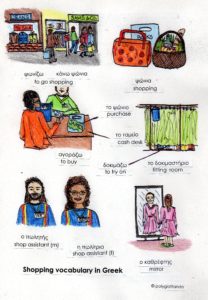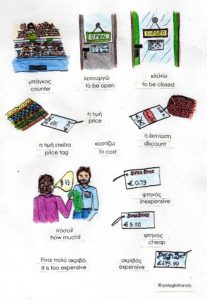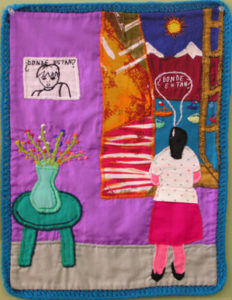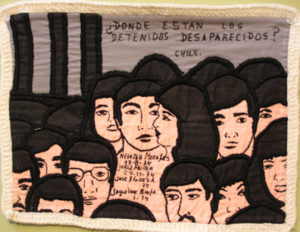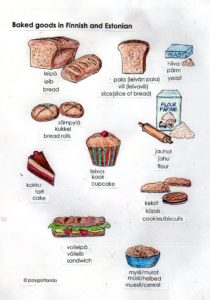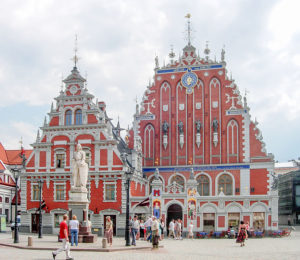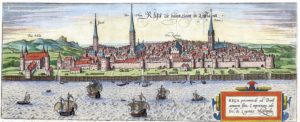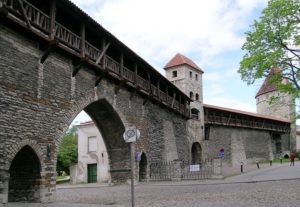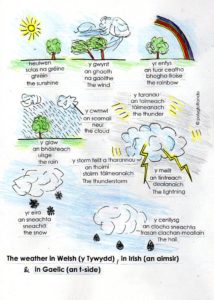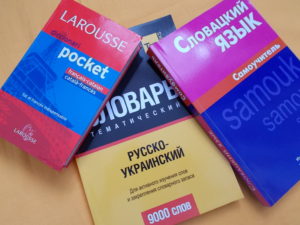Today’s blog post will take us to South Eastern Europe, namely to Greece, and to some vocabulary around the theme of shopping.
Category Archives: multilingual
Focus on art/foco en arte: Arpilleras from/de Chile (bilingual post/entrada bilingüe)
Scroll down for the English text!!
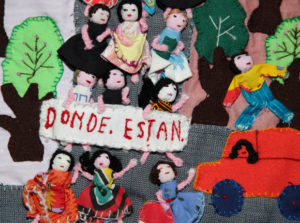
¿Dónde están?/Where are they? Anon. Chile, early 1980s
Photographer, Martin Melaugh (all images © Roberta Bacic), via http://www.latin-american.cam.ac.uk/events/arpilleras-dialogantes/arpillera-conversations
Esta semana, nuestro viaje nos lleva a Sudamérica, más precisamente a Chile, y a una forma distintiva de arte popular de este país – las arpilleras.
Arpilleras son tapices o imágenes textiles multicolores hechas con retales distintas que cuentan una historia y las experiencias de la vida cotidiana del pueblo. Son documentos históricos, mensajes de protesta y una forma del arte popular y del patriomonio al mismo tiempo. Tienen su origen en la dictatura militar de Augusto Pinochet Ugarte en Chile (1973-1990), durante la cual servían a documentar, a expresar y a denunciar la opresión y los crimenes del régimen porque todas otras formas de expresión libre normales eran prohibidas.
Las arpilleras chilenas fueron hechas por arpilleristas, grupas de mujeres cuyos maridos y/o hijos eran entre los víctimas del régimen, los así llamados ‘desaparecidos’ o ‘detenidos’. Fueron hechas en talleres organizados por una comisión de la Iglesia Católica chilena y entonces distribuídas en secreto al extranjero por la Vicaria de la Solidaridad, un grupo de derechos humanos de la iglesia católica de Santiago. El gobierno chileno consideraba las arpilleras traicioneras y prohibía su venta o exposición en el país, y por eso las primeras tapices fueron pasadas de contrabando al extranjero en bolsas diplomáticas. El régimen también confiscaba todos los paquetes, bolsas o maletas en los que sospecharon arpilleras. Por esta razón y para proteger a las mujeres, los tapices generalmente eran sin firmar. A menudo las ganancias de su venta en el entranjero eran los únicos ingresos de las arpilleristas porque a los parientes de detenidos o desaparecidos prohibieron hacer la mayoría de los trabajos.
Las raíces de las arpilleras datan de la época de los años 60 cuando una industria casera se desarrolló que producía bordados decorativos con escenas de la vida doméstica y rural con lana y hilos coloridos. Sin embargo, después del golpe militar en 1973, había escasez de lana y como consecuencia las arpilleristas empezaban a utilizar retales de paños por sus tapices. Las mujeres se reunían en pequeños talleres de un sólo cuarto en las afueras de Santiago cada semana para trabajar juntas. Cada taller tenía más o menos 20 miembros y a cada arpillerista se le permitió hacer sólo una arpillera cada semana, a menos que su necesidad de dinero era tan grande que el grupo decidió que podía hacer dos. El grupo también determinó el tema de las arpilleras cada semana. Cada arpillera era el trabajo de una mujer individual que desarrolló el diseño en el taller y luego lo cosió en casa.
Había algunas reglas respecto a los temas y a lo que podía ser mostrado en los tapices o no: por ejemplo, escenas de tortura u otros temas abiertamente políticos eran prohibidos, tanto como otras imágenes fuertes que puedan provocar el gobierno a detener a las mujeres. Solo eran permitidos eslóganes y palabras que también aparecían en la vida cotidiana, como sobre pancartas de manifestantes. Temas corrientes y comunes de las arpilleras son escenas de la vida rural y cotidiana, generalmente con los Andes en el fondo como testimonio e indicio de que las cuentas representadas tenían lugar en Chile, y casas, árboles y figuras humanas – generalmente tridimensionales con piezas como cabezas, brazos, etc. que resaltan de la superficie plana. Imágenes recurrentes incluyen ollas comunes (grandes calderos negros sobre un fuego) que la Iglesia chilena suministraba, los talleres de arpilleras mismos, las bombas de agua comunales y panaderías y lavanderías cooperativas que eran organizadas para ayudar a los pobres. Representaciones más políticas incluían grupos de manifestantes que llevaban pancartas y distribuían folletos políticos – ambos actos ilegales – , la policía militar con uniformes oscuros o puertas de fábricas y hospitales con una X sobre ellas, lo que significaba que eran cerradas a las familias de los desaparecidos o detenidos. Otros temas frecuentes eran niños que rebuscaban y coleccionaban cartones para venderlos, que lavaban coches o hacían cola delante de los hospitales o para recibir leche, o líneas eléctricas que la gente conectaba con las líneas eléctricas principales durante la noche para robar electricidad después de que el gobierno cerró su suministro de electricidad. Otros materiales, como por ejemplo frijoles secos, piezas de plástico, de papel, metal o de madera, fueron también cosidos o pegados a la superficie de las arpilleras.
Sin embargo, no todas las arpilleras mostraban escenas políticas y denunciantes: Algunas retratan una vida ‘idealizada’ como las mujeres la habrían deseado, con niños alegres, un paisaje pacífico, mercados florecientes y un buen Sistema de asistencia sanitaria, etc. – en breves palabras, retratos que expresaron el deseo y la esperanza de un futuro mejor. Por otro lado, había también talleres de arpilleras sancionados por el gobierno en los que mujeres fieles a la dictatura cosían tapices de propaganda, con temas alegres que retrataron a Chile como un país próspero con un gobierno benévolo. Con el tiempo, el arte de las arpilleras fue también adoptado por la gente en otros países latinoamericanos, especialmente en Perú, Nicaragua y Colombia, y sus tapices casi siempre retratan una vida feliz.
English text:
Today’s blog post is taking us to South America and Chile and to an art form that originated in this country, namely the Arpilleras, patchwork tapestries that were made by groups of women, the arpilleristas, during the military dictatorship of General Augusto Pinochet Ugarte (1973-1990) in Chile. The name arpillera derives from the Spanish word for ‘burlap’ (=arpillera), a type of sackcloth onto which the designs were sewn.
Arpilleras are small figurative patchwork tapestries made from scraps of fabric, which tell a story and the experiences of daily life of the makers and typically depict images of hardship, violence and of oppressive living conditions and human rights abuses during the regime. They are historical records, protest messages and a form of folk art and heritage at the same time. They have their origin in the military dictatorship of Augusto Pinochet Ugarte in Chile (1973-1990), during which all normal means of free speech and of free expression were prohibited and so they served as an outlet to document, denounce and express the oppression and crimes of the regime.
The Chilean arpilleras were made by the arpilleristas, groups of women whose husbands and sons were among the desaparecidos, literally ‘those who have disappeared’, and the detained. They were made in workshops organized by a commission of the Chilean Catholic Church and then distributed abroad in secret by the Vicaria de la Solidaridad, the Vicarate of Solidarity, a human rights group of the Catholic church of Santiago. The Chilean government considered the arpilleras as traitorous and prohibited their sale and exhibition in the country. Therefore, the first tapestries had to be smuggled out of the country in diplomatic pouches. The regime also confiscated all packages, bags and suitcases in which they suspected arpilleras. For this reason and to protect the women, the tapestries were usually not signed. The proceeds from their sale abroad was often the only source of income of the arpilleristas because the relatives of the detained and disappeared were barred from most jobs.
The roots of this folk art practice date back to the 1960s when a home-based industry developed which produced decorative embroidered wall hangings with scenes of domestic and rural life made from wool and colourful threads. However, after the military coup in 1973, there was a scarcity of wool and so the arpilleristas started using fabric scraps for their tapestries. The women met in small one-room workshops in the outskirts of Santiago each week to work together. Each workshop had about 20 members and each arpillerista was only allowed to make one tapestry each week, unless she was so needy that the group allowed her to make two. The group also decided a topic for the tapestries to be made that week, but each arpillera was nevertheless the work and design of an individual woman who developed the design in the workshop and then sewed the tapestry at home.
There were several rules about subject matter and about what could be shown in the tapestries and what not: for example, scenes of torture and other overtly political topics were prohibited, as well as other strong images which could provoke the government to detain the women. Only slogans and phrases which also appeared in daily life, like on banners of demonstrators, could be included. Recurring and common subjects of the arpilleras are scenes of rural and daily life, usually with the Andes mountains, los Andes, in the background as a testimony and an indication that the stories represented in the tapestries took place in Chile, as well as trees, houses and human figures – generally three-dimensional with pieces like arms, heads, etc. projecting from the flat surface. Other recurring imagery includes the so-called ‘common pots’, or ollas comunes (big black cauldrons on a fire), i.e. soup-kitchens which the Catholic church provided, the arpillera workshops themselves, communal water pumps and co-operative bakeries and laundries, which were organized to help the poor. More political images include groups of demontrators who carried banners and distributed political pamphlets – both of which were illegal actions – , the military police with their dark uniforms or doors of factories and hospitals with an X on them, which signalled that they were barred for the families of the desaparecidos, ‘those who have disappeared’, and of the detained. Further recurring subjects are children who searched for and collected cardboards to sell, who washed cars or were queuing in front of hospitals or to receive some milk, as well as electrical lines which people connected to the main power lines at night to steal electricity after the government shut down their own power supply. Other materials, like for example dried beans (frijoles secos), pieces of plastic, metal or wood, were also sewn or glued to the surface of the arpilleras.
However, not all of these patchwork tapestries showed political or denouncing subject matter: Some painted the picture of an ‘idealized’ life which the women would have wished to have, with happy children, peaceful landscapes, flourishing markets and a good health care system, etc. – in short, images which expressed the wish and hope for a better future. On the other hand, there were also workshops for government-sanctioned arpilleras, in which women loyal to the dictatorship sewed propaganda tapestries, with cheerful subject matter which portrayed Chile as a prosperous country with a benevolent government. Over time, the folk art of making arpilleras was taken over by people in other Latin American countries, especially Peru, Nicaragua and Colombia, and their tapestries almost always show scenes of a happy life.
Further reading:
What is an Arpillera? http://benton.uconn.edu/exhibitions/arpilleria/what-is-an-arpillera/
Telling the story https://www.brandeis.edu/ethics/events/past/tellingthestory/agosin.html
Vocabulary: The Environment in Norwegian, Danish and Swedish
Today’s blog post will take us to Scandinavia, and to some thematic vocabulary about a topic of current importance, namely the environment, in Swedish, Danish and Norwegian.
Norwegian/Norsk
Miljøet = the environment
globale oppvarming = global warming
Klimaendringen = climate change
Drivhuseffekten = Greenhouse Effect
utslipp av karbondioksid = carbon dioxide emissions
drivhusgasser = greenhouse gases
havnivåstigningen/ Havnivåendring = sea level rise
økosystemet = ecosystem
biologisk mangfoldet = biodiversity
en truet art = a threatened species
ørkendannelse = desertification
en regnskog = rainforest
avskogningen = deforestation
forurensningen = pollution
sur nedbør = acid rain
holdbar = sustainable
fornybar = renewable
fornybar energy = renewable energy
bærekraft = sustainability
Danish/Dansk
Miljøet = the environment
global opvarmning = global warming
Klimaændringen = climate change
Drivhuseffekten = Greenhouse Effect
Kuldioxidudslippet = carbon dioxide emissions
Drivhusgasser = greenhouse gases
stigende vandstand i havene = sea level rise
økosystemet = ecosystem
biodiversitet = biodiversity
en truet art = a threatened species
ørkendannelse = desertification
en regnskov = rainforest
skovrydningen = deforestation
forureningen = pollution
syreregn = acid rain
bæredygtig = sustainable
Vedvarende = renewable
vedvarende energi = renewable energy
bæredygtighed = sustainability
Swedish/Svenska
Miljön = the environment
Global uppvärmning = global warming
Klimatförändringen = climate change
Växthuseffekten = Greenhouse Effect
Koldioxidutsläppet = carbon dioxide emissions
Växthusgaser = greenhouse gases
höjning av havsnivån/havsnivåhöjning = sea level rise
ekosystemet = ecosystem
den biologiske mångfald = biodiversity
en hotad art = a threatened species
ökenspridningen = desertification
en regnskog = rainforest
avskogningen/skogskövlingen = deforestation
miljöförstöring = pollution
surt regn = acid rain
hållbar = sustainable
förnybar = renewable
förnybar energi = renewable energy
hållbarhet = sustainability
Vocabulary: Baked goods in Finnish and Estonian
Survival vocabulary in Latvian, Lithuanian and Estonian
Today’s blog post is taking us to North-Eastern Europe again, namely to the 3 Baltic countries (Estonian: Balti riigid, Baltimaad, Latvian: Baltijas valstis, Lithuanian: Baltijos valstybės) Estonia Eesti, Latvia Latvija and Lithuania Lietuva and to their respective languages. Estonian belongs to the Balto-Finnic branch of the Uralic languages, whereas Latvian and Lithuanian belong to the Baltic language group of the Indo-European languages.
Survival vocabulary in Latvian
Sveiks (said to a male)/Sveika (said to a female) = Hello
Labdien = Good day/afternoon, hello
Uz redzēšanos! = goodbye!
Jā / nē = yes / no
Paldies = Thank you
Lūdzu = please; you are welcome
Vai jūs runājat latviski/angliski? = Do you speak Latvian/English?
Atvainojiet = excuse me
Piedodiet = sorry, I apologize
Kā jums klājas? = How are you?
Labi, paldies = fine, thank you
Kā jūs sauc? = What is your name?
Mani sauc… = My name is…
Prieks iepazīties! = Nice to meet you!
No kurienes jūs esat? = Where are you from?
Es esmu no… = I am from…
Survival vocabulary in Lithuanian
Labas/ sveiki = hello
Laba diena = good day (‘good afternoon’)
Sudie = goodbye
Taip/ ne = yes, no
Ačiū!/Dėkoju! = Thank you
Prašom! = please; you are welcome; here you are; don’t mention it
Ar jūs kalbate angliškai? = Do you speak English?
Aš nesuprantu = I don’t understand
Kaip gyvuojate? = How are you?
Man viskas gerai = I am fine
Kaip jūsų vardas? = What is your name?
Mano vardas yra… = My name is…
Malonu = nice to meet you
Atsiprašau = excuse me
Atleiskite = sorry
Iš kur jūs esate? = Where are you from?
Aš esu iš… = I am from…
Survival vocabulary in Estonian
Tere = hello
Head aega = goodbye
Jah/ei = yes/no
Vabandage = excuse me; sorry
Aitäh/tänän = thank you
Palun = you are welcome; please
Kas te räägite eesti/inglise keelt? = do you speak Estonian/English?
Kust te pärit olete? = where are you from?
Mis te nimi on? = What is your name?
Minu nimi on…/Ma olen… = My name is…/I am…
Väga meeldiv = nice to meet you
Kuidas läheb? = how are you?
Hästi = fine
Vocabulary: ‘The weather’ in Celtic languages
Today’s blog post is continuing our series on the comparison of vocabulary of closely related languages and is taking us to the British Isles again, as well as to Brittany (Bretagne) in France, and to the various Celtic languages spoken there, namely Welsh, Irish and Scottish Gaelic, as well as Cornish and Breton. Our topic today is the weather and the most important words related to it. Both Welsh (Cymraeg) and Cornish (Kernewek) belong to the Brittonic group of the Celtic languages (to which also Breton Brezhoneg belongs), and Irish (Gaeilge) and Scottish Gaelic (Gàidhlig) belong to the Goidelic group (to which also Manx Gaelg belongs).
The terms for these weather-related words in Cornish/Kernewek:
weather – kewer, sunshine – Howl, wind – gwyns, rainbow – kammneves, rain – glaw, clouds – kommol, thunder – taran, thunderstorm – hagarawel derednow, lightning – lughes, snow – ergh, hail – keser
and in Breton/Brezhoneg:
the weather – an amzer, sunshine – Heol, wind – avel, rainbow – kanevedenn, rain – glav, cloud – koumoul, thunder – taran, thunderstorm – arnev, lightning – luc’hed, snow – erc’h, hail – grizilh
How to avoid mixing up closely related languages
Today’s blog post continuous our series on efficient learning and revision strategies in language learning and will show you some simple methods with which you can avoid mixing up closely related languages.
A simple but very efficient method of learning or revising closely related languages is to use textbooks and learning materials written in one of the languages to learn or revise the other one. To give an example, if you tend to mix up, let’s say, Spanish and Portuguese, or Spanish and Italian, then use some materials that are written in your ‘stronger’ language of the two to revise or learn the other. The great advantage of this method is that you see the two languages directly side by side in comparison. If you compare the vocabulary when revising, you will see exactly where the two languages converge and use a very similar or even identical word or expression, and where they depart and use a quite different word or phrase. A nice side effect of this technique is also that you can practice and revise two languages at the same time. And in the case that you really do not understand a word or phrase in either of the languages, you can always look up that word or phrase in a dictionary in your native tongue. A further advantage of using materials written for speakers of one of the two languages for learning the other is that these books and resources will usually point out the pitfalls precisely for speakers of one of the languages in learning the other and often contain tips on which aspects in particular to pay attention to avoid any such mistakes and ‘false friends’.
If you prefer online-resources to books, then you can use the same technique on duolingo, both for revision and to learn a new language. One of the nice things about this platform is that many languages are available in a wide range of language combinations, especially the more popular languages, so that you can choose one that suits you best, e.g. learning Italian via Spanish, or a Spanish-Portuguese combination, etc. The system will then show you exactly where the sentences in both languages converge and depart in their vocabulary and grammatical structures. Those readers who know the platform will know how strict the system is about a very precise translation of the words and sentences. If you practice regularly in this way, you will be far less likely to mix up the similar languages over time.
Colour perception in various languages

Today’s blog post will be about colour perception in different cultures and languages around the world.
The terms for colours cannot always be translated in a straightforward manner since some colours, esp. green and blue (“grue”) in some Asian languages, are often perceived differently from those in the West, and are considered separate colours in those countries whereas in English there is just one term for both shades or vice versa.
Russian
In Russian, there are two different terms for blue which are considered as separate colours and not just as shades of the same colour as in English: голубой (‘goluboy’) light blue and синий (‘siniy’) dark blue.
Hungarian
In Hungarian, there are two separate terms for red: piros is a bright red and vörös is a dark red.
German
In German, there are two different terms for pink: Pink is the same bright saturated shade as in English, but when the colour is pale pink it is called rosa.
‘Grue’ or green and blue in various Asian languages
The origin of the perception of a green-blue (‘grue’) colour, which in English is called ‘teal’ or is seen as two separate colours (blue and green), comes from the Chinese character 青 (qīng).
The colour qīng 青 can mean either of the colours that in English are referred to as ‘green’, ‘blue’, or ‘black’, depending on the context and the nouns or fixed phrases it is used with. To give an example, qing means ‘blue’ when used with ‘sky’ 青天 (qīngtiān) or ‘eyes’青眼 (qīngyǎn) , but ‘black’ when used with ‘hair’ 青丝(qīngsī) and ‘green’ when used with the character for ‘mountain’ 青山 (qīngshān), ‘grass’青草 (qīngcǎo) or ‘vegetables’ 青菜 (qīngcài).
Qing 青 , according to tradition, is the colour of things that are born and the term 青春 (qīngchūn ‘green spring’) means youth. This is connected to its meaning ‘black’ since young people in China have dark hair, or 青鬓 (qīng bìn) ‘black temple hair’, an idiom referring to young people. Qing can also refer to black clothes or fabrics and one of the main female roles in Chinese opera, 青衣 (qīngyī), refers to the fact that most actors wear black clothing.
Qing can also refer to the colour ‘blue’, which originates from the dye bluegrass which in ancient times was used to dye things in the colour of qing. The idiom 青出於藍,而勝於藍/青出于蓝,而胜于蓝 (qīngchūyúlán ér shèng yú lán, ‘blue comes from the indigo plant but is bluer than the plant itself’) describes how a student could come to excel their teacher.
The character 青qing originally derives from the components for 生 ’growth of plants‘ and 丹 ’cinnabar‘, which was also used for dyeing and by extension came to refer to ‘colour’ in general, so 青qing came to be known as the ‘colour of growing plants’ and green-blue, and came to describe a range of colours from light green through blue to deep black 玄青 (xuánqīng). Over time, the character for cinnabar was exchanged with the similar character for ‘moon’月.
The modern Mandarin Chinese language, however, also has the blue–green distinction with 蓝/ 藍 lán for blue and 绿 / 綠 lǜ for green. Another peculiarity of Chinese colour perception is the case of ‘red’ 红 / 紅, hóng and ‘pink’ 粉红, fěn hóng (lit.’powder red’), which are considered varieties of a single colour.
青 qing (Cantonese 廣東話 )
In Cantonese, qing 青 can describe the same range of colours as in Mandarin Chinese. It means ‘green’ when referring to grass, plants or the mountains, ‘blue’ when referring to the sky or stones, and ‘black’ or ‘young’ when referring to hair or fabrics. However, in Cantonese (廣東話), 青 qing meaning ‘black’ is still used in contexts where the use of 黑 would be inauspicious since it is a homophone of ‘乞’ (beggar), for example 黑衣, ‘black clothes’, would also mean ‘beggar’s clothes’.
Vietnamese
Vietnamese has taken over the green-blue colour perception from the ancient Chinese character 青 and is read as xanh, which can mean both ‘green’ or ‘blue’ depending on the context. To specify which shade exactly you mean, you have to add some descriptive terms, so xanh da trời means ‘blue as the sky’, xanh dương or xanh nước biển means ‘blue as the ocean’ and xanh lá cây means ‘green like the leaves’. Vietnamese sometimes uses the terms xanh lam for blue and xanh lục for green, which derive from the Chinese characters 藍and 綠 respectively.
Japanese
Also Japanese has the colour green-blue, or ao 青 (hiragana あお, romaji ao, historical hiragana あを), which also derives from the ancient Chinese character and its connotations. So ao 青 can mean ‘blue’, ‘green’ or ‘black’ depending on the context. In the case of Japanese, the colour connotation ‘black’ comes from the bluish-black colour of a horse’s hair. Ao is also used in particular to refer to the green of traffic lights and to the colour of plant leaves, vegetables and apples. By contrast, other ‘green’ objects will generally be referred to as being 緑 midori, e.g. clothes, cars, etc.
Lakota
Also in the native American language Lakota (‘Sioux’), one word is used for both blue and green, namely the term tȟó. However, a term for ‘green’ – tȟózi- has come into use, which is made up of the terms tȟó meaning ‘blue-green’ and zí meaning ‘yellow’. In the same way, zíša/šázi refers to the colour orange, šá on its own meaning ‘red’. The colour purple or violet is thus šátȟo/tȟóša.
Some interesting links for further reading on the topic:
https://en.wikipedia.org/wiki/Blue%E2%80%93green_distinction_in_language
http://www.theworldofchinese.com/2013/06/what-color-is-qing/
https://en.wiktionary.org/wiki/%E9%9D%92
Does your language also have a different colour perception from the English one? Let us know in the comments!! 🙂

